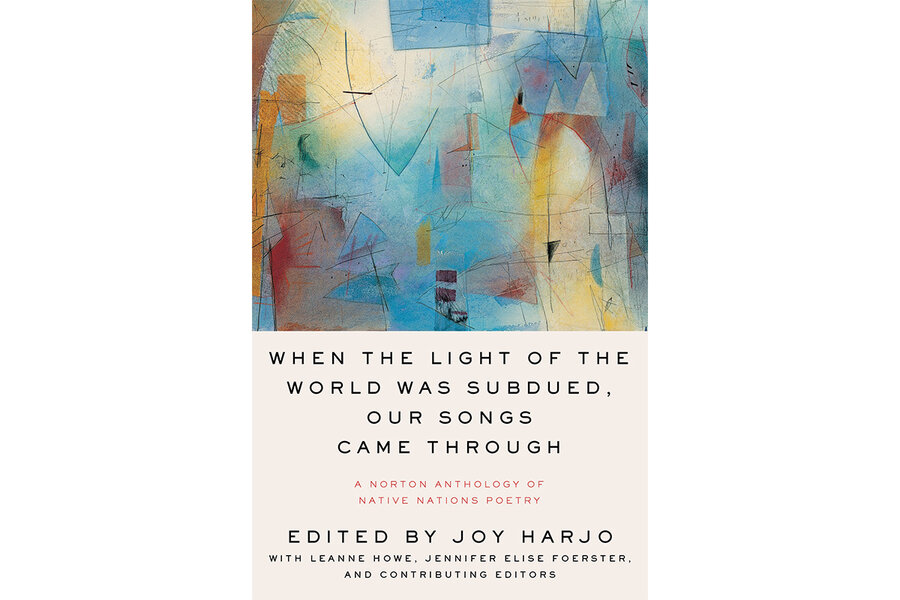Native American poetry anthology vibrates with powerful voices
Imagine if you could step back in time and meet people whose stories have been ignored or suppressed. As one person after another spoke, your view of history would be altered in profound and indelible ways.
That scenario is similar to what Joy Harjo, United States poet laureate, and contributing editors have created with “When the Light of the World Was Subdued, Our Songs Came Though: A Norton Anthology of Native Nations Poetry.”
The collection features 161 poets from more than 90 Indigenous nations – including N. Scott Momaday, Louise Erdrich, and Layli Long Soldier. The engrossing, often riveting book is organized by geographic area, with powerfully insightful essays that convey the distinctiveness and diversity of each region.
Yet as Harjo notes in her introduction, “Many who open the doors of this text arrive here with only stereotypes of indigenous peoples that keep indigenous people bound to a story in which none of us ever made it out alive. In that story we cannot be erudite poets, scholars, and innovative creative artists. It is the intent of the editors to challenge this: for you to open the door to each poem and hear a unique human voice speaking to you beyond, within, and alongside time.”
The reader’s journey begins in the Northeast and Midwest with a translation of an Anishinaabeg dream song, an elegy written in 1678 by one of Harvard’s first Indigenous students, and a variety of poems from the 1800s. These reflect a deep spirituality and intimacy with the natural world, as well as the devastation caused by wave after wave of settlers encroaching on ancestral lands.
Over time, colonization and broken treaties impacted every aspect of life as Indigenous nations were forced to relocate, families lost their livelihoods, and children were sent to military-style schools to learn English and “unlearn” their heritage, history, and language.
William Walker Jr., a Wyandot rights advocate from the 1800s, addressed these losses in his poem “Oh, Give Me Back My Bended Bow”:
You took me from my native wild,
Where all was bright, and free and blest;
You said the Indian hunter’s child
In classic halls and bowers should rest.
Long have I dwelt within these walls
And pored o’er ancient pages long.
I hate these antiquated halls;
I hate the Grecian poet’s song.
Decades later, Olivia Ward Bush-Banks expressed profound sorrow in “On the Long Island Indian”:
Now remains a scattered remnant
On these shores they find no home,
Here and there in weary exile,
They are forced through their life to roam.
As the collection continues, readers meet poets from the Great Plains and Rocky Mountains; Pacific Islands, Pacific Northwest, and Alaska; Southwest and West; and the Southeast. The variety and range of their work are stunning – from rhythmic, meditative poems to spoken word and abstract pieces – as is the tragic history that shapes so much of the writing.
“Political content is one characteristic of Native poets of the Plains and Mountains,” notes Heid E. Erdrich. Familiar historical events and figures – such as Sitting Bull and Crazy Horse – inform perspectives here, as does the deep conviction that “history is active and ongoing, rather than residing in distant memory.”
Poets from Alaska, in contrast, often “reflect an eternal connection to place that runs through their veins cycling through the generations,” writes Diane L’xeis’ Benson. These poets wrestle with loss, cultural disruption, and the difficulty of maintaining their cultural existence in an increasingly commercial world.
Endurance and survival are some of the themes explored in the poetry of the Southwest and West. “They tell the stories inside of us,” writes Deborah A. Miranda. They also “bear us forward into what comes next, the futures we rise to meet or take in our hands, carve out for coming generations.”
These are broad brushstrokes, of course. The anthology is nuanced and complex. Writers explore identity, universal concerns, and the challenge of writing about their cultures. Often, this means balancing the past and present, in search of a new way forward.
Casandra López exemplifies this in “A New Language,” which opens with the desire for “50 words for grief / and 50 words for love.” The poem ends with this declaration:
In this new language our bones say
sun and sea, reminding us of an old
language our mouths have forgotten, but
our marrow remembers.
Other young writers, such as Tommy Pico and Natalie Diaz, who was recently named to the longlist for the 2020 National Book Award in poetry, use edgy verse to challenge stereotypes. Their efforts continue a long tradition of innovative, evocative writing.
As Jennifer Elise Foerster explains in her comments about the Southeast, the poets “of the nineteenth and early twentieth centuries often engaged the same language that was stripping them of human rights.” This allowed the appearance of assimilation, while subtly conveying resistance, wit, irony, and grief.
The full range of emotions and responses is evident throughout this compelling collection, which leaves the reader wanting more from each writer yet eager to begin the next selection.
Together, those voices convey the importance and power of poetry, which held customs, song, and hope, and couldn’t be taken away.







